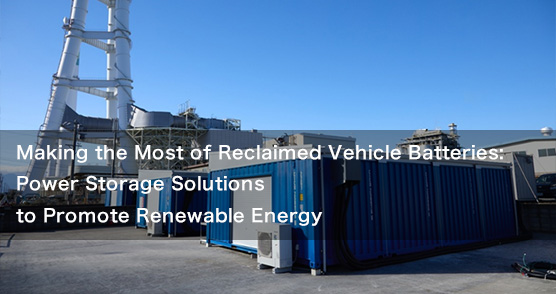Connecting to the Next Generation:
University Students Consider the Future of Energy
12 April 2023
INDEX
Operating at Full Capacity Under a Soft Blanket of Snow
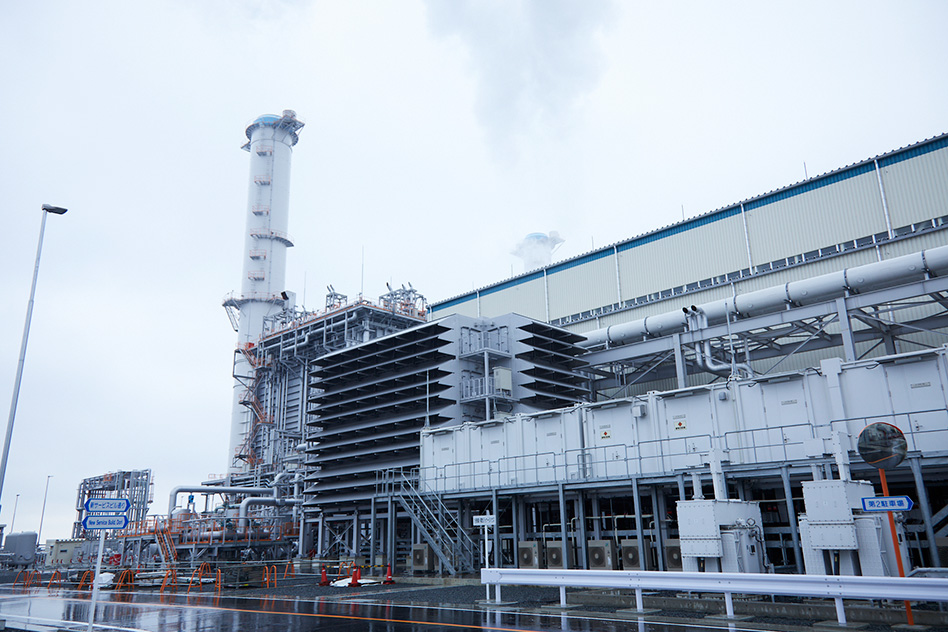
It's 10:00 a.m. on Friday, February 10, 2023. The air is humid in the Kanto and Chubu regions due to a southern low-pressure system, signaling a downturn in the weather. A shift from rain to snow is expected.
Despite the weather, Anegasaki Thermal Power Station in Ichihara City, Chiba Prefecture, greets its visitors with a warm welcome. The power plant has garnered attention given its potential to alleviate anticipated power shortages in the Tokyo metropolitan area next winter after resuming operations at Units 5 and 6, which had previously entered the long-term planned shutdown phase. New Unit 1 employs a gas turbine combined cycle power generation system and began operation on February 1 this year, with commercial operation of New Units 2 and 3 scheduled to begin soon. Anegasaki is also home to JERA's state-of-the-art LNG-fired* power plant that boasts the world's highest standard of power generation efficiency (*LNG meaning “liquefied natural gas”).
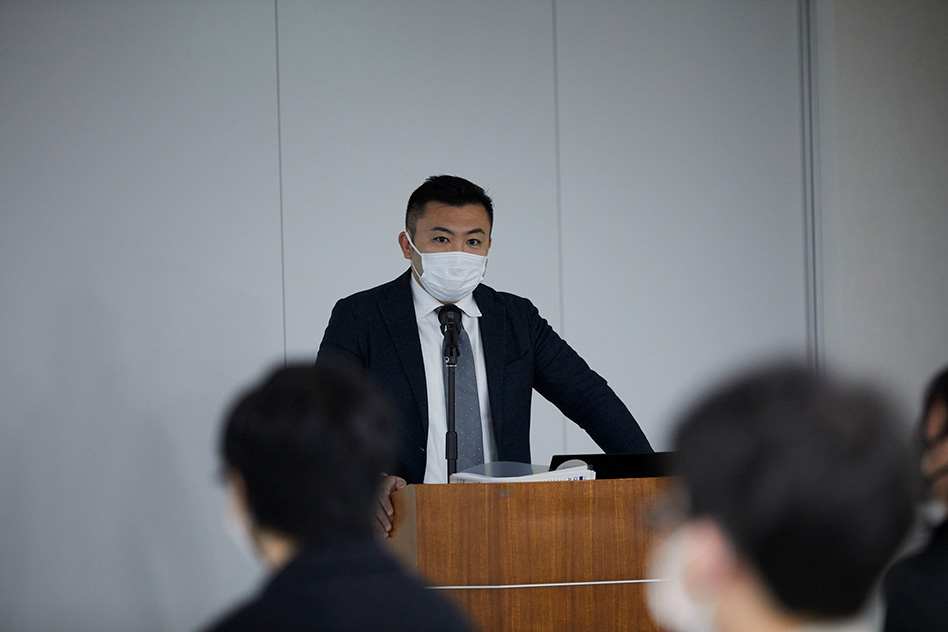
Orientation is delivered by an official from the Ministry of Economy, Trade and Industry (METI), who begins by discussing the main principles of Japan’s S+3E energy policy (Safety, Energy Security, Economic Efficiency, and Environment).
“Today's weather conditions and cooler outside temperatures have resulted in a greater-than-normal demand for electricity. The new state-of-the-art Unit 1 and reactivated Units 5 and 6 are operational to fulfill their role in providing a stable supply of electricity to the region. A sufficient amount of electricity needs to be generated in lockstep with demand. As such, it is difficult to provide adequate supply using only renewable energy sources, whose output fluctuates with the weather. Thermal power generation plays a vital role in flexibly bridging the gap between fluctuating demand and renewable energy generation. Today, I would like to ask you to entertain that perspective when thinking about the future of energy,” says Sugawara, who has traveled from METI to deliver the introductory address.
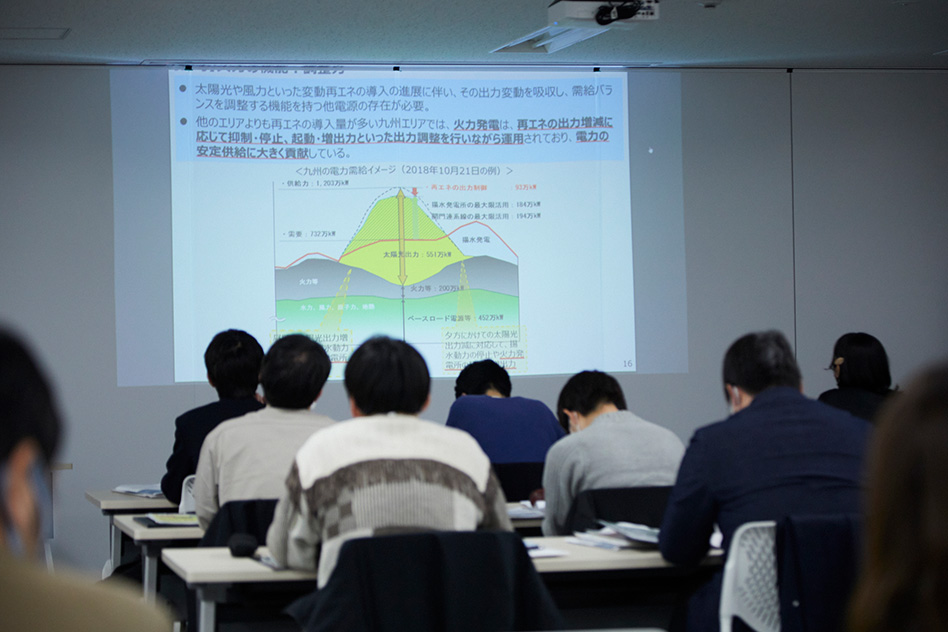
Twenty university students participate in today's activities, having been selected through an open application process for this opportunity to gain a multifaceted view of the current state of energy.
Today's event, titled “New Energy Field: On-site Experience to Support Our Way of Life and Create the Future,” was organized by the Agency for Natural Resources and Energy as part of the Next Generation Program. Twenty university students were selected through an open application process to participate in a rare exclusive tour inside the thermal power plant. The agency has organized the event to raise awareness among the next generation regarding its plans and roadmap for Japan's “Green Growth Strategy Through Achieving Carbon Neutrality in 2050.” JERA's dedication to next-generation development has been pivotal in bringing this program to fruition, in line with its CSR policy.
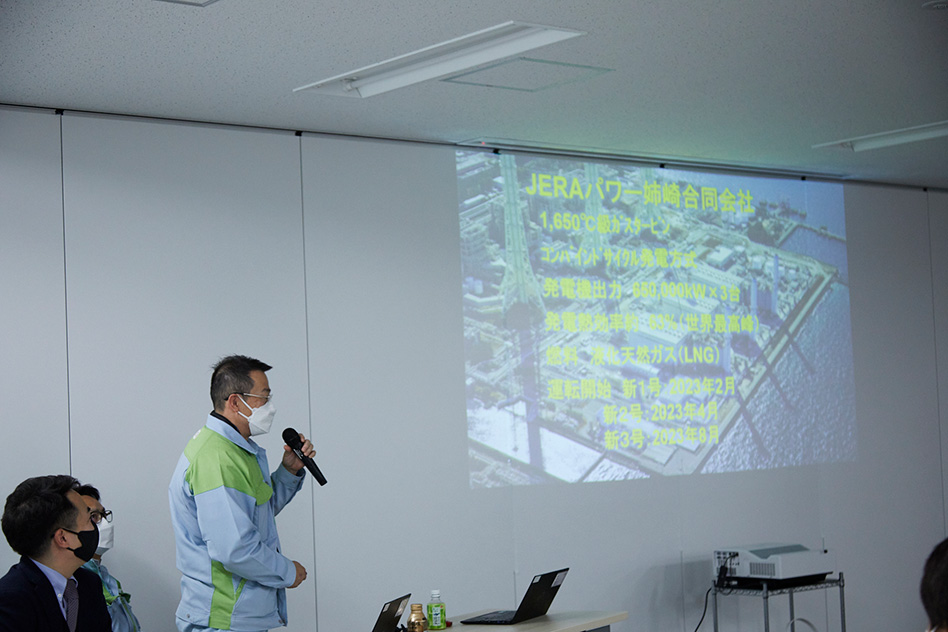
The deputy director of the Anegasaki Thermal Power Station explains the history of the facility and the state-of-the-art features of the recently commissioned Unit 1.
At JERA's orientation session, the company describes JERA Zero CO2 Emissions 2050, its plan to achieve virtually zero carbon dioxide emissions from domestic and overseas operations by 2050 in order to build a sustainable society. During the ongoing dialogue, the students start to demonstrate an enhanced ability to perceive the energy industry's future as their own. The perspectives of these twenty students from across the country seem to evolve as they listen to representatives from the Agency for Natural Resources and Energy and JERA, which is responsible for about 30% of Japan's electricity supply.
Learning the Current Reality of Thermal Power Plants through Fieldwork
“This is New Unit 1. There are two main types of thermal power generation. The first type is steam power generation, which utilizes the expansive power of steam to generate electricity. The second type is gas turbine power generation, which uses combustion gasses produced by burning fuel to rotate turbines and generate electricity. New Unit 1 uses a combined cycle power generation system that integrates both technologies. The combination of gas turbine and steam turbine power can generate electricity by recovering heat from the high-temperature gas emitted by the gas turbine and using it to generate steam that rotates the steam turbine. This method of power generation uses thermal energy more efficiently than conventional power generation methods that exclusively use steam turbines, and it is environmentally friendly due to its lower CO2 emissions, ”says Deputy Director Saga, who is in charge of the new facilities at the Anegasaki Thermal Power Station. New Unit 1 started commercial operation on February 1, 2023.
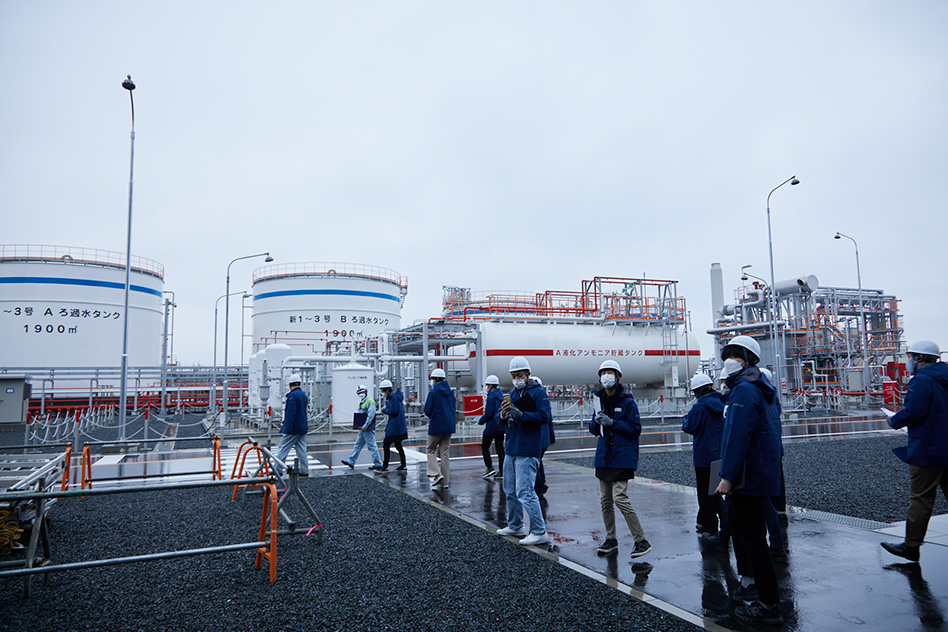
Participants split into two teams and begin their tour of the power plant, savoring this rare glimpse inside.
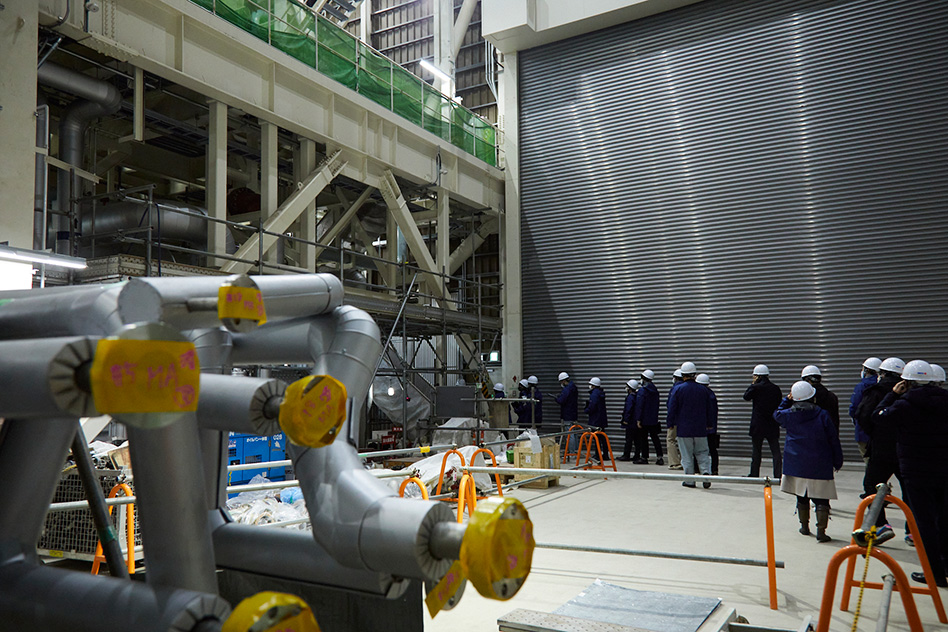
Students also get a look inside New Unit 1, which features the world's highest standard of power generation efficiency. The inner workings of the machine, however, are kept top-secret.
Ikari, deputy director of the plant, who in charge of the old facilities, smiles as he engages with the students. “The original Units 1 through 4 began operation in December 1967 but were decommissioned in December 2021. They have been reborn as new facilities that do not emit sulfur oxides or particulate matter. The units also use natural gas, which has the lowest CO2 emissions per unit calorific value among all fossil fuels and reduces our environmental footprint. We have also introduced state-of-the-art low NOx combustors and exhaust gas denitration equipment that significantly reduce toxic substance emissions."
After seeing these cutting-edge facilities, participants tour the old power generation facilities, including Unit 6. They also visit the central control room for Units 5 and 6, which, as of February 10, 2023, are in the process of resuming operations. The central control room is the heart of the power plant, where specialized technical staff operate and monitor activities 24 hours a day, 365 days a year. "While these units were scheduled to go offline, we are now asking them to work overtime to help stabilize the electricity supply through the use of thermal power.”
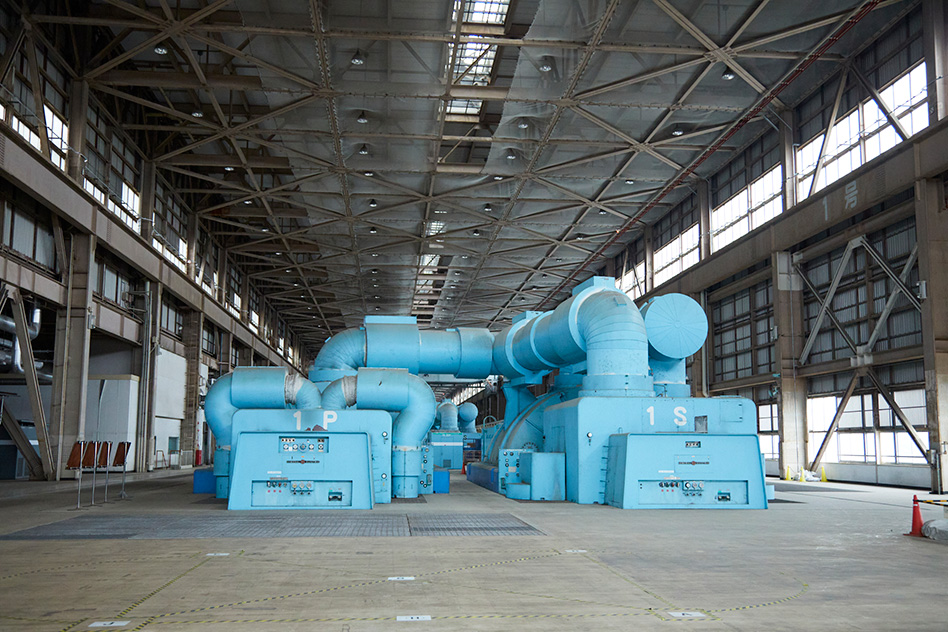
Anegasaki Thermal Power Station Units 1–4 were decommissioned in December 2021.
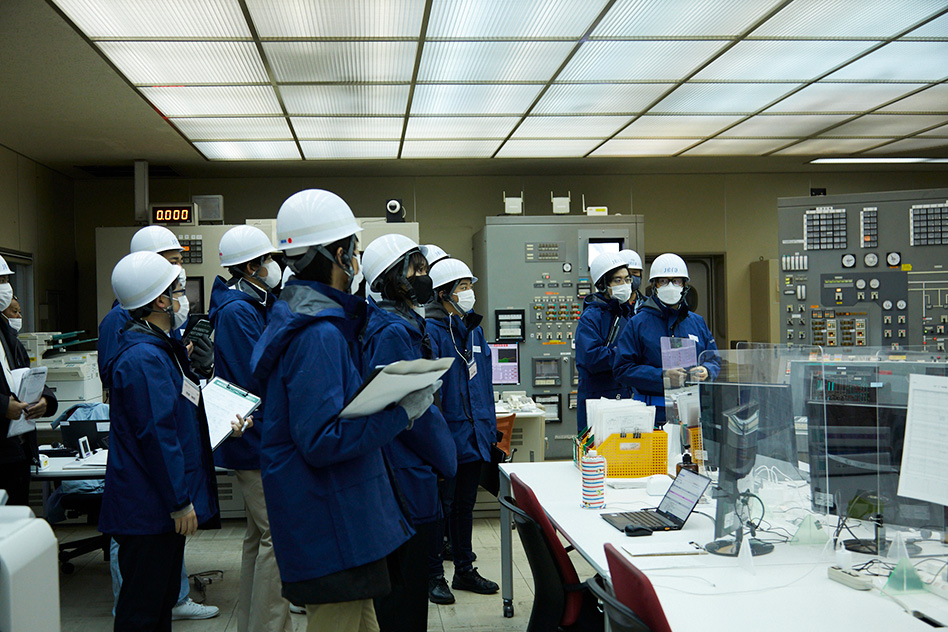
Students visit the central control room for Units 5 and 6, which are set to resume operations. Unlike New Unit 1, which is controlled by computers, there are several operators in the control room for Units 5 and 6 who run the switchboards.
The operators stress that they are continuously improving their equipment expertise and never overlook even the most minor damage. The students ask many questions during the tour.
The total length of the building that houses the original, decommissioned Units 1 to 4 and the active Units 5 and 6 is over 400 meters. A "farewell" banner hangs near the entrance to the central control room of Units 1 and 2.
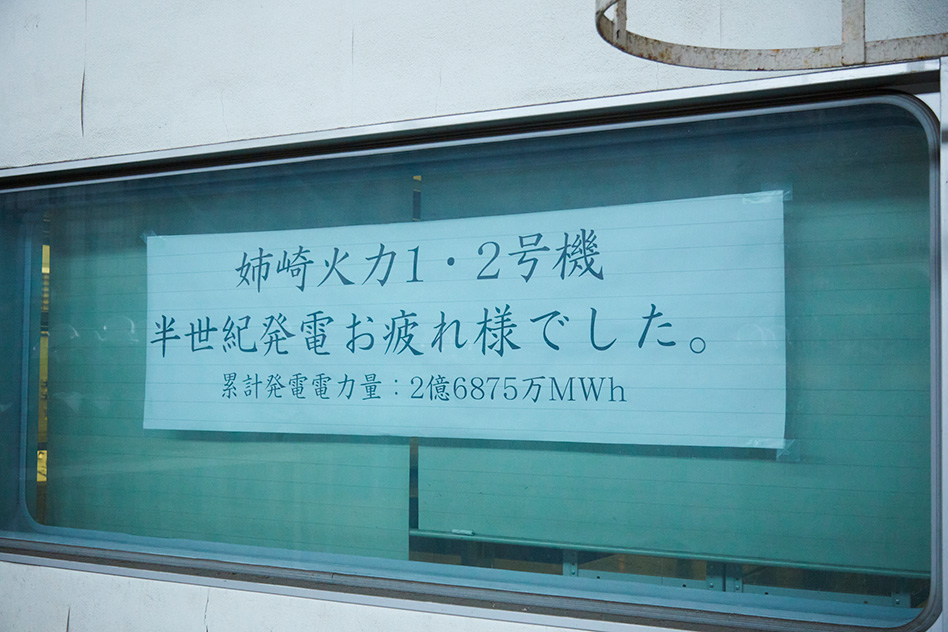
A farewell banner hangs near the entrance to the central control room of Units 1 and 2. The banner is a symbol of the affection that workers at the plant feel for these units that generated power for half a century.
JERA’s Approach to Educating Future Generations
In the afternoon, group work begins. Students participating in the workshop must first answer seven questions on a quiz titled "What if energy became like this?" The quiz has been prepared by the Agency for Natural Resources and Energy and QuizKnock, the company of "The University of Tokyo Quiz King" Takuji Izawa. The quiz is a unique challenge with no right answers. Its real goal is to get students thinking about the what-ifs of energy in Japan.
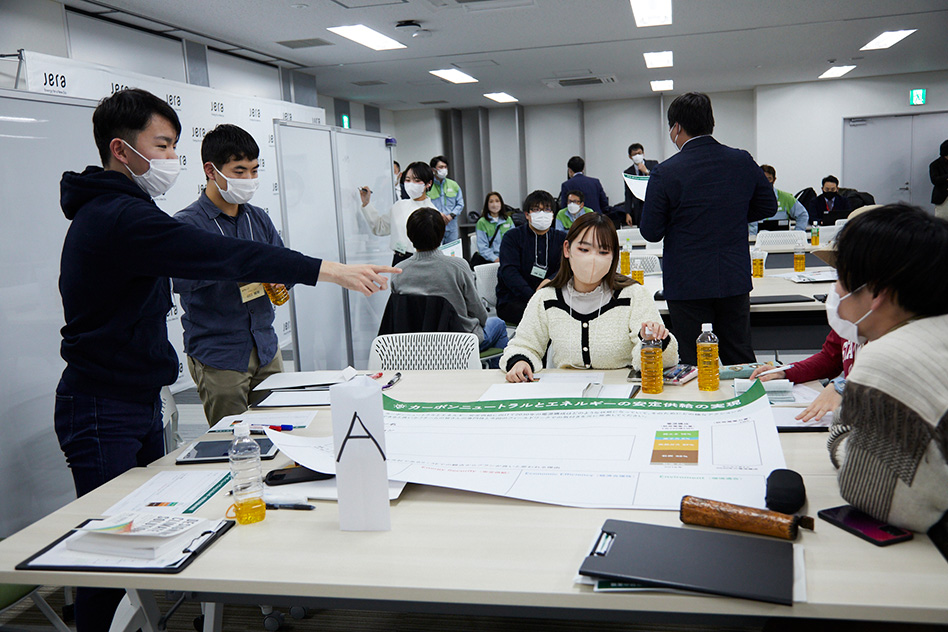
The students break into four teams and begin their group work. With the orientation and tour complete, participants turn to each other for serious discussions.
Students are divided into four teams to begin their group work. They are given the theme of "carbon neutrality in the pursuit of a stable energy supply" and asked to discuss what an optimal power supply structure in 2030 might look like and what actions we would need to take to get there. Students are instructed to start with their thoughts on what the future of energy should look like and then backcast using the S+3E energy policy to identify the steps needed to overcome any obstacles to achieving their vision. They then discuss how they could contribute to the future of energy and present their conclusions.
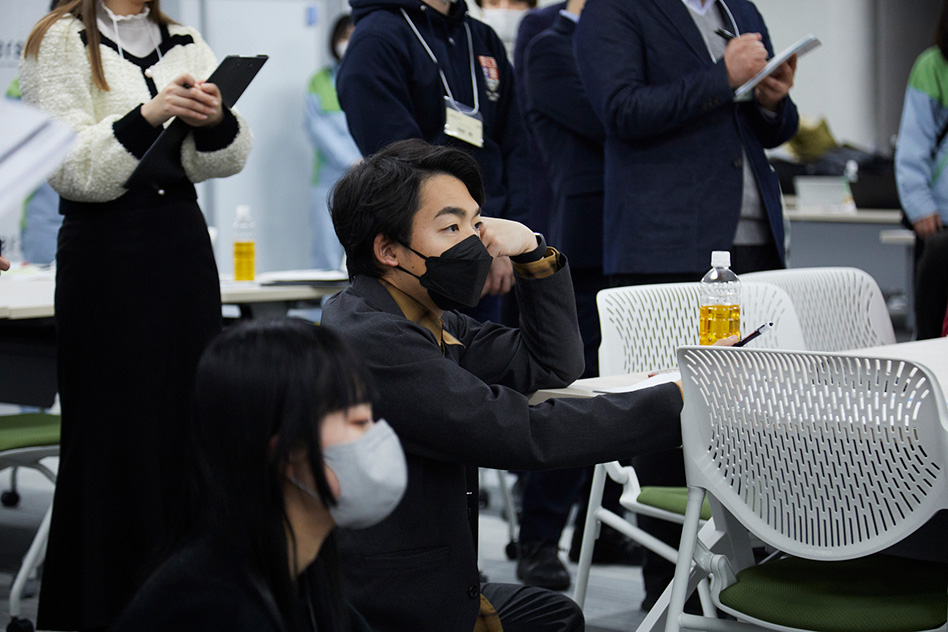
Takuji Izawa (center) also participates in the group work. He listens attentively and offers insightful advice, which impresses the students during their group discussions.
Each of the four teams engages in active discourse. As if flipping a switch, Izawa's straightforward advice during the group discussion has a transformative effect on each student, and lively discussions ensue.

After an hour and a half of group work, each team presents their conclusions on this year's theme of carbon neutrality in the pursuit of a stable energy supply, their serious demeanor underscoring the weight of the task.
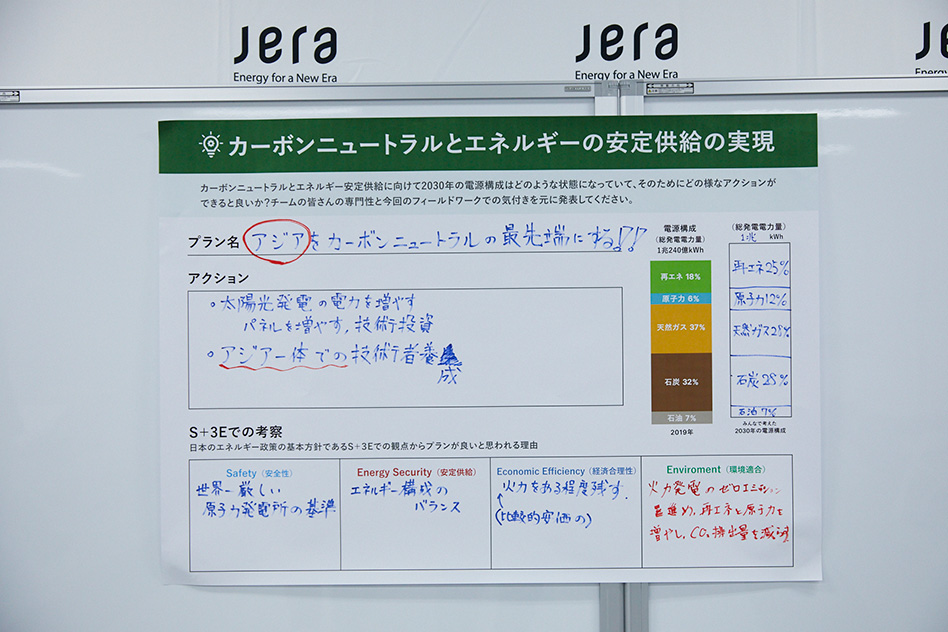
There is no point for Japan to pursue carbon neutrality alone, which is why, with this premise in mind, Team C concludes that Japan and its advanced technology should take the lead in making energy policy proposals for APAC by 2030.
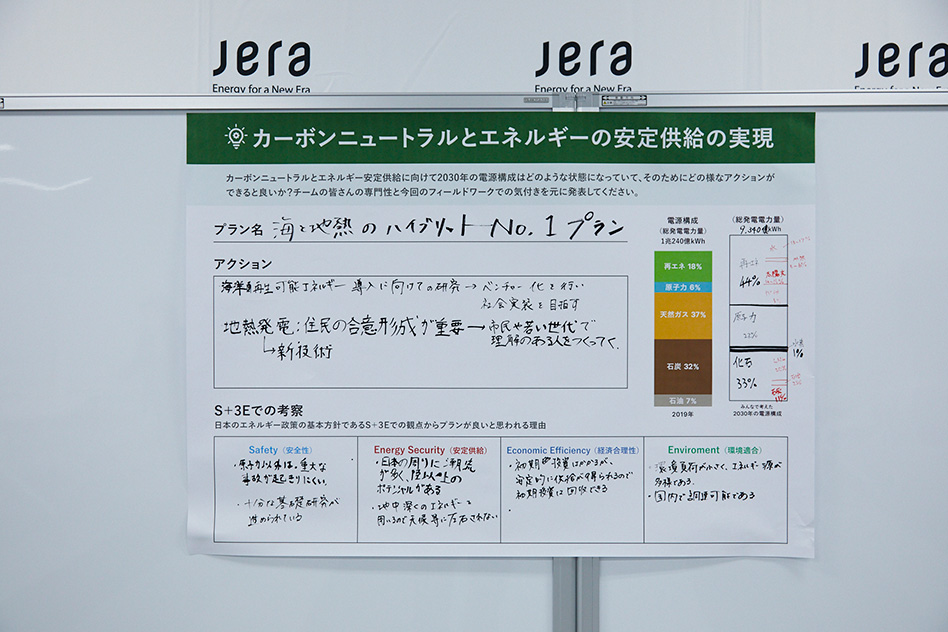
Team B plans to leverage Japan's strengths in ocean and geothermal energy resources, a strategy that requires communication with the community prior to implementation. They consider what kinds of discussions must take place to earn the support of the local community. The team hopes the younger generation will play a key role in creating this shared understanding.
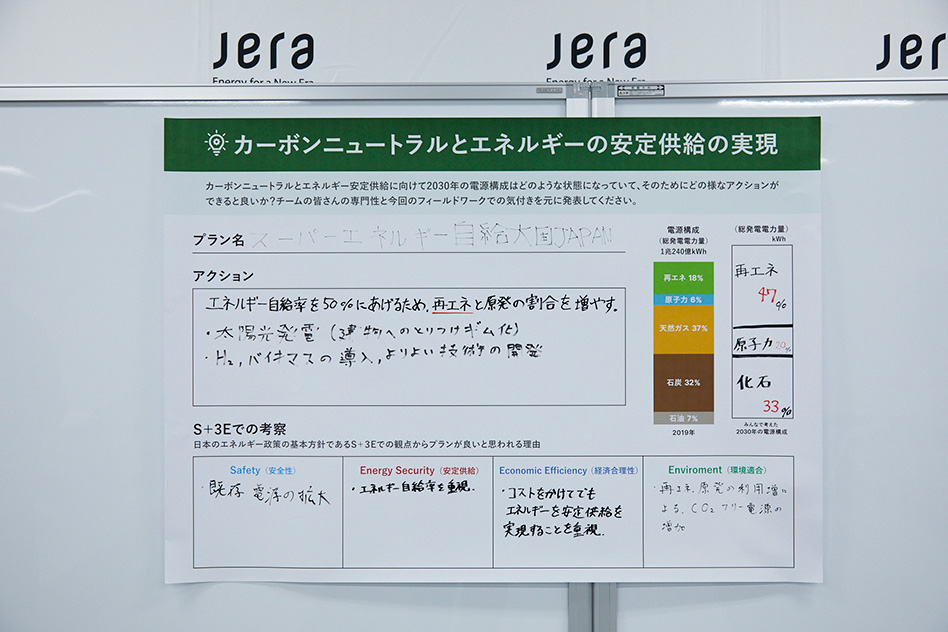
Team A believes that tipping the scales further toward renewable energy resources, with a focus on energy self-sufficiency, could lead to a future with a stable energy supply. They propose making Japan a "self-sufficient super energy powerhouse." Izawa comments that the team did as much as they could with the theme but realized that energy issues can quickly become complex when economic rationality comes into play.
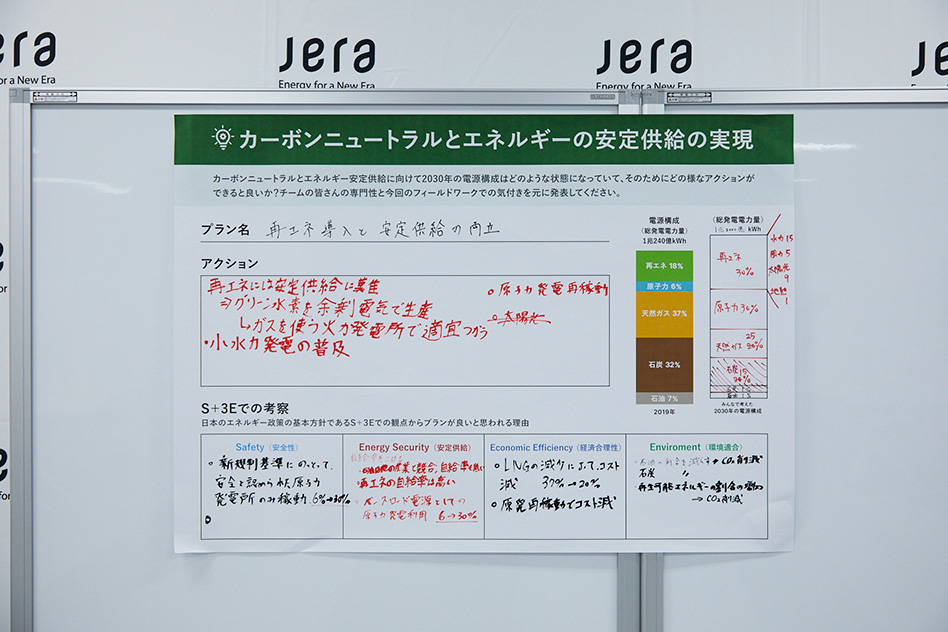
Team D begins its discussion by considering power structures. Today, nuclear power accounts for 30% of all electricity generation in Japan due to economic reasons, and a lively debate ensues about the share of renewable energy sources and thermal power. It proves difficult for the students to balance economic rationales with the need for a stable energy supply.
The workshop comes to an end with Izawa sharing his thoughts.
“My hope for today was for each of you to adopt a multifaceted perspective towards the future of energy and to continue thinking about it, no matter how complex the topic may be. As I listened to the presentations, I thought that each team came up with a plan that was unique and original. On the other hand, as we made Japan's energy challenges our own during the workshop, we questioned how to translate our proposals into tangible actions, and I think we hit a wall that left us wondering, ‘Can this even be done?’ Many difficulties stand in the way of realizing our goals, and I'm sure you've found many reasons why it may seem impossible. Nevertheless, we have no choice but to continue to confront the multi-layered reality in front of us. Through today’s activities and this workshop, I hope that you all have learned to think about the future of energy with unyielding resolve.”
There is a common thread between Izawa's comments and JERA's views on fostering the next generation.
Through its efforts to achieve a sustainable society, JERA also recognizes that educating future generations is a top priority for any CSR initiative. The company has created enjoyable learning environments for elementary school children and their families to discover the wonders of electricity. It has also conducted online tours of power plants to increase awareness of electricity and supported the activities of SAKURA Tempesta, a junior high and high school student robot competition team. In order to lead energy into a new era, JERA will continue to pass on the skills and expertise gained through its business operations to the next generation and contribute to the education of individuals who can lead the global future of energy.
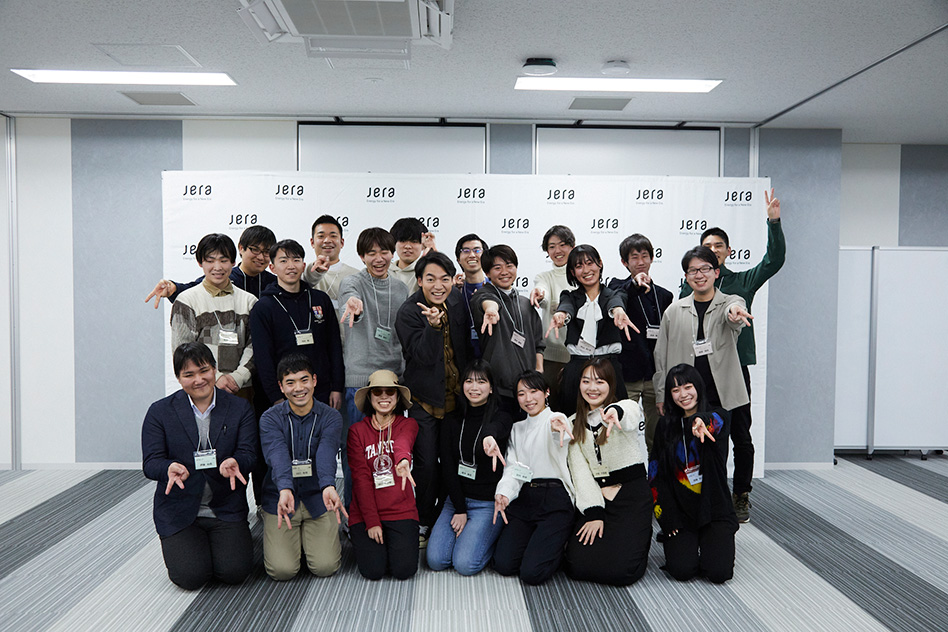
Following the group presentations, students engage in further discussions that delve into the conclusions they had reached earlier and end their tour with a commemorative photo with Izawa (center).


